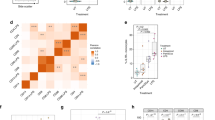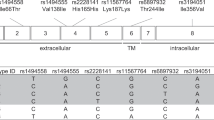Abstract
Interleukin (IL)-10 is an important cytokine in immune regulation and promotes B-cell proliferation and antibody production. High levels of IL-10 were found in subjects with autoimmune diseases. The A to G single nucleotide polymorphism at –1087 of the IL-10 promoter is associated with differences in promoter activity and IL-10 production. The objectives of this study were to analyze differences in the transcription factor binding to the –1087 IL-10 gene polymorphism in B-cells, the influence of the A to G transition on the IL-10 and Sp1 gene expression in B-cells after lipopolysaccharide (LPS) stimulation and the effect of knockdown of Sp1 on IL-10 gene expression. Using B-cell lines obtained from subjects with GG and AA genotypes for the −1087 polymorphism and chromatin immunoprecipitation assay, we showed that the transcription factors PU.1 and Spi-B bound to both G and A alleles, whereas the transcription factor Sp1 only bound to the G allele. LPS stimulation of the B-cells resulted in a larger increase in IL-10 and Sp1 gene expression for GG genotypes than AA genotypes and knockdown of Sp1 gene expression resulted in a decrease in IL-10 mRNA transcription. IL-10 production was higher for the GG genotype than for the AA genotype.
This is a preview of subscription content, access via your institution
Access options
Subscribe to this journal
Receive 6 digital issues and online access to articles
$119.00 per year
only $19.83 per issue
Buy this article
- Purchase on Springer Link
- Instant access to full article PDF
Prices may be subject to local taxes which are calculated during checkout






Similar content being viewed by others
References
Kantor AB . A new nomenclature for B cells. Immunol Today 1991; 12: 388.
Porakishvili N, Mageed R, Jamin C, Pers J-O, Kulikova N, Renaudineau Y et al. Recent progress in the understanding of B-cell functions in autoimmunity. Scand J Immunol 2001; 54: 30–38.
Csiszár A, Nagy GY, Gergely P, Pozsony T, Pócsik E . Increased interferon-gamma (IFN-gamma), IL-10 and decreased IL-4 mRNA expression in peripheral blood mononuclear cells (PBMC) from patients with systemic lupus erythematosus (SLE). Clin Exp Immunol 2000; 122: 464–470.
Klinman DM, Steinberg AD . Systemic autoimmune disease arises from polyclonal B cell activation. J Exp Med 1987; 165: 1755–1760.
Salgame P, Abrams JS, Clayberger C, Goldstein H, Convit J, Modlin RL et al. Differing lymphokine profiles of functional subsets of human CD4 and CD8T cell clones. Science 1991; 254: 279–282.
Burastero SE, Casali P, Wilder RL, Notkins AL . Monoreactive high affinity and polyreactive low affinity rheumatoid factors are produced by CD5+ B cells from patients with rheumatoid arthritis. J Exp Med 1988; 168: 1979–1992.
Dauphinée M, Tovar Z, Talal N . B cells expressing CD5 are increased in Sjogren's syndrome. Arthritis Rheum 1988; 31: 642–647.
Zheng NY, Wilson K, Wang X, Boston A, Kolar G, Jackson SM et al. Human immunoglobulin selection associated with class switch and possible tolerogenic origins for C delta class-switched B cells. J Clin Invest 2004; 113: 1188–1201.
Berglundh T, Liljenberg B, Tarkowski A, Lindhe J . The presence of local and circulating autoreactive B cells in patients with advanced periodontitis. J Clin Periodontol 2002; 29: 281–286.
Sugawara M, Yamashita K, Yoshie H, Hara K . Detection of, and anti-collagen antibody produced by, CD5-positive B cells in inflamed gingival tissues. J Periodontal Res 1992; 27: 489–498.
Moore KW, de Waal Malefyt R, Coffman RL, O’Garra A . Interleukin-10 and the interleukin-10 receptor. Annu Rev Immunol 2001; 19: 683–765.
Burdin N, Rousset F, Banchereau J . B-cell-derived IL-10: production and function. Methods 1997; 11: 98–111.
Llorente L, Richaud-Patin Y, Fior R, Alcocer-Varela J, Wijdenes J, Fourrier BM et al. In vivo production of interleukin-10 by non-T cells in rheumatoid arthritis, Sjogren's syndrome, and systemic lupus erythematosus. A potential mechanism of B lymphocyte hyperactivity and autoimmunity. Arthritis Rheum 1994; 37: 1647–1655.
Llorente L, Richaud-Patin Y, Wijdenes J, Alcocer-Varela J, Maillot MC, Durand-Gasselin I et al. Spontaneous production of interleukin-10 by B lymphocytes and monocytes in systemic lupus erythematosus. Eur Cytokine Netw 1993; 4: 421–427.
Mongan AE, Ramdahin S, Warrington RJ . Interleukin-10 response abnormalities in systemic lupus erythematosus. Scand J Immunol 1997; 46: 406–412.
O’Garra A, Chang R, Go N, Hastings R, Haughton G, Howard M . Ly-1 B (B-1) cells are the main source of B cell-derived interleukin 10. Eur J Immunol 1992; 22: 711–717.
Aramaki M, Nagasawa T, Koseki T, Ishikawa I . Presence of activated B-1 cells in chronic inflamed gingival tissue. J Clin Immunol 1998; 18: 421–429.
Tabeta K, Yamazaki K, Hotokezaka H, Yoshie H, Hara K . Elevated humoral immune response to heat shock protein 60 (hsp60) family in periodontitis patients. Clin Exp Immunol 2000; 120: 285–293.
Rees LE, Wood NA, Gillespie KM, Lai KN, Gaston K, Mathieson PW . The interleukin-10-1082 G/A polymorphism: allele frequency in different populations and functional significance. Cell Mol Life Sci 2002; 59: 560–569.
Suárez A, Castro P, Alonso R, Mozo L, Gutiérrez C . Interindividual variations in constitutive interleukin-10 messenger RNA and protein levels and their association with genetic polymorphisms. Transplantation 2003; 75: 711–717.
Unterberger C, Staples KJ, Smallie T, Williams L, Foxwell B, Schaefer A et al. Role of STAT3 in glucocorticoid-induced expression of the human IL-10 gene. Mol Immunol 2008; 45: 3230–3237.
Kube D, Platzer C, von Knethen A, Straub H, Bohlen H, Hafner M . et al. Isolation of the human interleukin 10 promoter. Characterization of the promoter activity in Burkitt's lymphoma cell lines. Cytokine 1995; 7: 1–7.
Kube D, Rieth H, Eskdale J, Kremsner PG, Gallagher G . Structural characterisation of the distal 5′ flanking region of the human interleukin-10 gene. Genes Immun 2001; 2: 181–190.
Eskdale J, Kube D, Tesch H, Gallagher G . Mapping of the human IL10 gene and further characterization of the 5′ flanking sequence. Immunogenetics 1997; 46: 120–128.
Mörmann M, Rieth H, Hua TD, Assohou C, Roupelieva M, Hu SL et al. Mosaics of gene variations in the Interleukin-10 gene promoter affect interleukin-10 production depending on the stimulation used. Genes Immun 2004; 5: 246–255.
Reuss E, Fimmers R, Kruger A, Becker C, Rittner C, Hohler T . Differential regulation of interleukin-10 production by genetic and environmental factors—a twin study. Genes Immun 2002; 3: 407–413.
Turner DM, Williams DM, Sankaran D, Lazarus M, Sinnott PJ, Hutchinson IV . An investigation of polymorphism in the interleukin-10 gene promoter. Eur J Immunogenet 1997; 24: 1–8.
Larsson L, Johansson P, Jansson A, Donati M, Rymo L, Berglundh T . The Sp1 transcription factor binds to the G-allele of the -1087 IL-10 gene polymorphism and enhances transcriptional activation. Genes Immun 2009; 10: 280–284.
Schug J . Using TESS to predict transcription factor binding sites in DNA sequence. Curr Protoc Bioinformatics 2008; Chapter 2: Unit 2 6: 1–15.
Matys V, Kel-Margoulis OV, Fricke E, Liebich I, Land S, Barre-Dirrie A et al. TRANSFAC and its module TRANSCompel: transcriptional gene regulation in eukaryotes. Nucleic Acids Res 2006; 34: D108–D110.
Westendorp RG, Langermans JA, Huizinga TW, Elouali AH, Verweij CL, Boomsma DI et al. Genetic influence on cytokine production and fatal meningococcal disease. Lancet 1997; 349: 170–173.
Kremer KN, Kumar A, Hedin KE . Haplotype-independent costimulation of IL-10 secretion by SDF-1/CXCL12 proceeds via AP-1 binding to the human IL-10 promoter. J Immunol 2007; 178: 1581–1588.
Lucas M, Zhang X, Prasanna V, Mosser DM . ERK activation following macrophage FcgammaR ligation leads to chromatin modifications at the IL-10 locus. J Immunol 2005; 175: 469–477.
Brightbill HD, Plevy SE, Modlin RL, Smale ST . A prominent role for Sp1 during lipopolysaccharide-mediated induction of the IL-10 promoter in macrophages. J Immunol 2000; 164: 1940–1951.
Chanteux H, Guisset AC, Pilette C, Sibille Y . LPS induces IL-10 production by human alveolar macrophages via MAPKinases- and Sp1-dependent mechanisms. Respir Res 2007; 8: 71.
Tone M, Powell MJ, Tone Y, Thompson SA, Waldmann H . IL-10 gene expression is controlled by the transcription factors Sp1 and Sp3. J Immunol 2000; 165: 286–291.
Miyake K . Innate recognition of lipopolysaccharide by Toll-like receptor 4-MD-2. Trends Microbiol 2004; 12: 186–192.
Steinke JW, Barekzi E, Hagman J, Borish L . Functional analysis of -571 IL-10 promoter polymorphism reveals a repressor element controlled by sp1. J Immunol 2004; 173: 3215–3222.
Perkins ND, Agranoff AB, Pascal E, Nabel GJ . An interaction between the DNA-binding domains of RelA(p65) and Sp1 mediates human immunodeficiency virus gene activation. Mol Cell Biol 1994; 14: 6570–6583.
Hoffmann SC, Stanley EM, Cox ED, Craighead N, DiMercurio BS, Koziol DE et al. Association of cytokine polymorphic inheritance and in vitro cytokine production in anti-CD3/CD28-stimulated peripheral blood lymphocytes. Transplantation 2001; 72: 1444–1450.
Crawley E, Kay R, Sillibourne J, Patel P, Hutchinson I, Woo P . Polymorphic haplotypes of the interleukin-10 5′ flanking region determine variable interleukin-10 transcription and are associated with particular phenotypes of juvenile rheumatoid arthritis. Arthritis Rheum 1999; 42: 1101–1108.
Yilmaz V, Yentür SP, Saruhan-Direskeneli G . IL-12 and IL-10 polymorphisms and their effects on cytokine production. Cytokine 2005; 30: 188–194.
Nelson JD, Denisenko O, Sova P, Bomsztyk K . Fast chromatin immunoprecipitation assay. Nucleic Acids Res 2006; 34: e2.
Sjöblom A, Yang W, Palmqvist L, Jansson A, Rymo L . An ATF/CRE element mediates both EBNA2-dependent and EBNA2-independent activation of the Epstein-Barr virus LMP1 gene promoter. J Virol 1998; 72: 1365–1376.
Vandesompele J, De Preter K, Pattyn F, Poppe B, Van Roy N, De Paepe A et al. Accurate normalization of real-time quantitative RT-PCR data by geometric averaging of multiple internal control genes. Genome Biol 2002; 3: RESEARCH0034 (e-pub ahead of print 18 June 2002).
Andersen LC, Jensen JL, Orntoft TF . Normalization of real-time quantitative reverse transcription-PCR data: a model-based variance estimation approach to identify genes suited for normalization, applied to bladder and colon cancer data sets. Cancer Res 2004; 64: 5245–5250.
Livak KJ, Schmittgen TD . Analysis of relative gene expression data using real-time quantitative PCR and the 2(-Delta Delta C(T)) Method. Methods 2001; 25: 402–408.
Author information
Authors and Affiliations
Corresponding author
Rights and permissions
About this article
Cite this article
Larsson, L., Rymo, L. & Berglundh, T. Sp1 binds to the G allele of the−1087 polymorphism in the IL-10 promoter and promotes IL-10 mRNA transcription and protein production. Genes Immun 11, 181–187 (2010). https://doi.org/10.1038/gene.2009.103
Received:
Revised:
Accepted:
Published:
Issue Date:
DOI: https://doi.org/10.1038/gene.2009.103
Keywords
This article is cited by
-
Expression profile of PU.1 in CD4+T cells from patients with systemic lupus erythematosus
Clinical and Experimental Medicine (2021)
-
Inflammation-related gene polymorphisms associated with Parkinson’s disease: an updated meta-analysis
Egyptian Journal of Medical Human Genetics (2020)
-
IL10 Promoter Polymorphisms are Associated with Rheumatic Heart Disease in Saudi Arabian Patients
Pediatric Cardiology (2016)
-
Significance of −1082A/G polymorphism of IL10 gene for progression of colorectal cancer and IL-10 expression
Tumor Biology (2014)
-
An association of interleukin-10 gene polymorphisms with Graves’ disease in two Chinese populations
Endocrine (2011)



